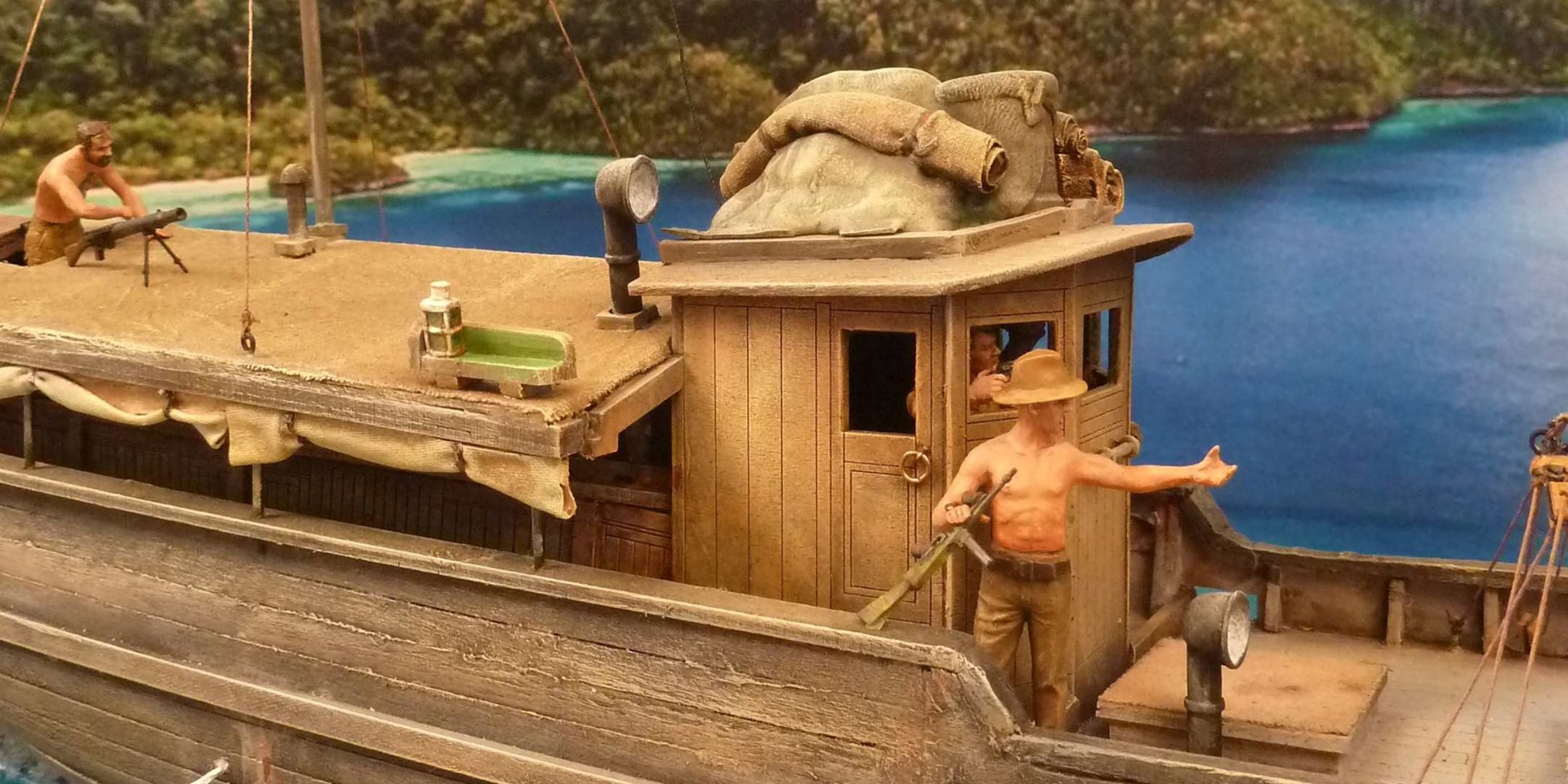

One of two dioramas created by volunteers Geoff Barnes and Roger Scott to commemorate the 75th anniversary of Operation Jaywick and the restoration of Krait. Image: Geoff Barnes.
Volunteers Geoff Barnes and Roger Scott have once again used their impressive model making skills to create a unique diorama for the Museum, commemorating the 75th anniversary of Operation Jaywick and the restoration of Krait.
Building Operation Jaywick in miniature
As a volunteer guide at the Museum, I noticed that Krait would be absent from display for quite some time due it’s extensive restorations. Luckily, an Australian model ship company, Modellers Central, released a laser-cut wooden 1:35 scale model to commemorate the 75th anniversary of the raid. Roger Scott and I proposed an exhibit of Krait in miniature so the Museum could have a ‘Krait’ display in Action Stations even when the real ship was in slip.
How to be in two places at once
What was more compelling: the clandestine night raid on Singapore Harbour or the cunning disguise used to slip into enemy territory? While discussing our plans for the model with curators David Payne and Stephen Gapps, it became obvious that the story of Operation Jaywick could not be told in one scene. It would have to be in two parts.

The diorama consists of two scenes, highlighting key moments during the tension-filled Operation Jaywick. The first scene was a larger diorama of Krait at sea, sailing past distant the Sebangka Island group. Dimensions 90cm wide by 50cm deep by 65 cm high. Curved scenic background 180cm wide by 65 cm high. Shadowless warm lighting. Image: Andrew Frolows/ANMM.
The first scene was a larger diorama of Krait at sea en route to Singapore, in a daylight setting with a sparkling sea, sailing past distant the Sebangka Island group. A large Chinese junk is a bit close for the crew’s comfort. Should the junk investigate them too thoroughly, they are warily preparing for action stations.
A second, smaller diorama features Lieutenant Page and Able Seaman Jones in Canoe No.3 at Pulau Bukum docks, Singapore. It is nighttime and the wharf is brightly lit. The canoe and crew hide in the shadow of large freighter while a Japanese sentry on the docks fails to notice their presence.

A smaller diorama features Lieutenant Page and Able Seaman Jones in Canoe No.3 at Pulau Bukum docks, Singapore. Dimensions 53cm wide by 32cm deep by 65cm high. Dockland background built into the diorama. Low level cold lighting. Image: Geoff Barnes.
Painting the night
The diorama boxes are internally lit but they are also subjected to ambient light spilling in from the windows of Action Stations. So, we were stumped: how to create a night-time scene in broad daylight? Traditionally, modellers use blue. But this blue ‘light’ is no good for the tropics, where the nights are warm and sticky, alive to the buzz of insects.
Light at night isn’t blue – it’s just 450,000 times weaker than direct sunlight. The illusion of low light during the raid had to be created by contrast: the seemingly dark dock and the shadows cast by the ship, in which the canoe is hiding, versus the glowing glare of the dock lights, where the Japanese sentry is standing.

The diorama buildings, ship and wharf are painted in a mix of burnt umber, olive green and a bit of Payne’s Grey. The attackers and their craft are virtually black. In contrast, the dock is lit with three miniature dock lamps creating pools of light. A dark blue sky looms behind the wharf, some clouds reflecting by the Singapore streets, but the whole background is actually much more brightly lit by a hidden strip of bright, cool LEDs.

In our diorama, Page and Jones are shocked to find themselves only metres away from this Japanese sentry, but he fails to notice their stealthy approach. Image: Geoff Barnes.
Hiding in plain sight
On 6 September 1943, the Krait hoisted it tattered Japanese flag and quit Exmouth Gulf. Destination – and target – Singapore. The team’s safety depended on maintaining the disguise. They were meticulous, even down to what sort of rubbish they threw overboard, lest a trail of European garbage arouse suspicion. U-boats had been tracked and destroyed in the Atlantic by just such carelessness.
They donned sarongs and stained their skin brown with dye to appear ‘Asian’. Unfortunately, the Helena Rubinstein makeup was for operas like Lakme or The Pearl Fishers, and what looked fine in the stage lights soon streaked badly at sea. Streaky stage make-up could have been painted on to the figures but without explanation, the streaking would have looked like poor painting.
Apart from the dangers posed by Japanese patrol boats and aircraft, the strong currents of the Lombok Straits posed significant navigational problems. Progress was excruciatingly slow but it was a relatively uneventful voyage, despite some nervous moments which called them to action stations. They saw an occasional Japanese aircraft and the searchlights of the coastal observation posts but trusted that their little craft would not attract attention.

Some of the crew aboard Krait, during training for Operation Jaywick. Australian War Memorial P0986/02/01.
— Geoff Barnes, Volunteer.
Visit the restored Krait and see the new short documentary film Dark Victory, Operation Jaywick: Singapore:1943 about the mission and its consequences for the people in Singapore.
Learn more about volunteering at the Museum.









